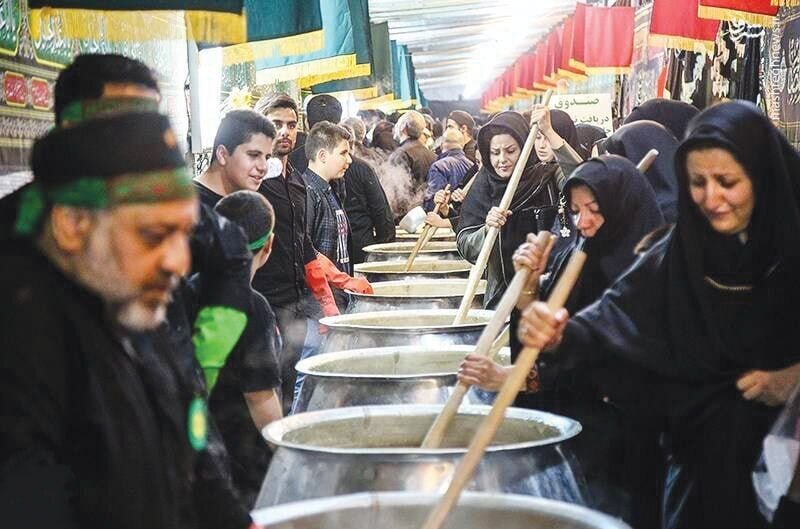By Afshin Majlesi

In Iran, the 28th of Safar, the second month of the lunar Hijri calendar, is a deeply significant day of mourning for Muslims. It is marked by rich observances and cultural practices that vary across different regions of the country.
This date marks the anniversary of the passing of Prophet Muhammad (PBUH) and the martyrdom of Imam Hassan (AS), the second Shia Imam. This solemn occasion is commemorated with a range of traditional mourning ceremonies and rituals, reflecting a rich arrays of cultural and religious practices that have evolved over centuries.
This major religious occasion falls on September 2 this year and is marked by an outpouring of collective grief and reflection.
The significance of Safar 28th
The 28th of Safar is observed by Muslims worldwide, but in Iran, it holds particular cultural resonance.
The day is not only a remembrance of the Prophet Muhammad's (PBUH) departure but also of Imam Hassan's (AS) martyrdom, which adds layers of significance to the mourning period. This day is integral to the larger context of mourning that spans from the first day of Safar to the end of the month.
Recitation of elegies
One of the central rituals of Safar 28th in Iran is the recitation of elegies. This practice involves the recitation of poetry and hymns that lament the deaths of the holy Prophet and his grandson. It serves as both an act of mourning and a means of keeping the memory of these revered figures alive. In every corner of Iran, communities gather to participate in elogy recitations, reflecting on the profound losses and drawing spiritual solace from their faith.

Food offerings
A distinctive feature of the mourning ceremonies is the preparation and distribution of special foods. Among the most common offerings are Sholeh Zard, a saffron-infused rice pudding, and Ash Sholeh Qalamkar, a hearty lentil and meat stew. These dishes are prepared as acts of charity, with the intention of feeding the less fortunate and sharing the blessings of the occasion with the community. The preparation of these foods is often a communal activity, involving families and neighbors coming together to fulfill these religious obligations.
'Diving into the Sea' tradition in Hormozgan
In the southern province of Hormozgan, there is a unique tradition known as "Del Sepordan Be Darya" or "Diving into the Sea," which takes place on the last Wednesday of Safar. This ritual signifies the end of the mourning period and the beginning of a new phase of life.

Participants go to the sea, passing through seven waves while reciting specific Quranic verses. This act is believed to cleanse individuals of sins and bring about a fresh start. After performing this ritual, people change out of mourning clothes and cleanse themselves with sweet water, symbolizing the transition from grief to renewal.
Mourning practices in village of Tut
In Yazd province, the village of Tut is renowned for its traditional mourning practices, particularly during the last decade of Safar.

The village is known for its historical Hosseiniyah, a place of mourning and remembrance, where dramatic reenactments known as Ta'ziyeh are performed. These performances, which date back over 200 years, depict the tragic events of Karbala and are a vital part of the community's mourning rituals. The village's Hosseiniyah and its Ta'ziyeh performances are significant cultural and religious landmarks.

Alam Vachini
One notable tradition is the "Alam Vachini" ceremony, which is particularly prominent in the Gilan province. This ritual, which has been practiced for centuries, takes place in a village near Astaneh Ashrafiyeh, where a ceremonial standard or flag, known as the "Alam," is adorned with 72 pieces of cloth in green, black, and red colors—representing martyrdom, mourning, and blood, respectively. The Alam is paraded around the shrine three times, and after the midday and afternoon prayers, it is carried in a grand procession by thousands of devotees. The ceremony concludes with the Alam being distributed among the participants as a token of blessing.

Sholeh Mokhtar
In the Fars province, specifically in the town of Gerash, special rituals are observed on the last Wednesday night of the month of Safar, which is the eve of the anniversary of the Prophet's and Imam Hassan's demise. Traditionally, this night is marked by placing fire pits at street corners and near old homes. Accompanying the fire are seven coins and seven pieces of sugar, and incense is burned over the flames.

Additionally, a special dish known as "Sholeh Mokhtar" is prepared and distributed among neighbors and family members. This dish is named after Al-Mukhtar ibn Abi Ubayd al-Thaqafi, a historical figure who led a pro-Alid revolt against the Umayyad Caliphate. The preparation and sharing of this dish are symbolic acts of solidarity and remembrance of his legacy.
These ceremonies, whether they involve the grand procession of the Alam or the local customs in Gerash, highlight the diverse ways in which Iranians honor the memory of Prophet Muhammad (PBUH) and Imam Hassan (AS). They serve as powerful expressions of faith, solidarity, and cultural continuity within the Shia Muslim community.
Chahardahomi ritual
Another notable practice in Hormozgan is the "Chahardahomi" or "Fourteenth Night" ceremony, held on the fourteenth of Safar.
This ritual, which has become less common in recent times, involves women and girls gathering to prepare fragrant mixtures of water and rosewater in a copper pot. As the moon rises, participants make wishes and place their jewelry into the pot.

No comments:
Post a Comment